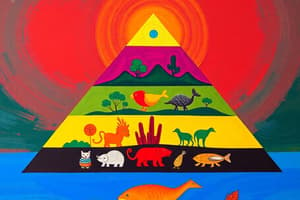Podcast
Questions and Answers
What are organisms?
What are organisms?
- Living things, such as plants, animals, or bacteria (correct)
- Only animals
- Non-living things
- Only plants
What is an energy pyramid?
What is an energy pyramid?
A diagram that shows the amount of energy available to pass from one level of a food chain to the next.
What are first-level consumers?
What are first-level consumers?
A type of consumer that eats producers (plants and algae).
What are second-level consumers?
What are second-level consumers?
What are third-level (tertiary) consumers?
What are third-level (tertiary) consumers?
What is competition in the context of organisms?
What is competition in the context of organisms?
What is camouflage?
What is camouflage?
What is symbiosis?
What is symbiosis?
What is mutualism?
What is mutualism?
What is parasitism?
What is parasitism?
What does extinct mean?
What does extinct mean?
What does threatened mean?
What does threatened mean?
What is pollution?
What is pollution?
What is acid rain?
What is acid rain?
What is deforestation?
What is deforestation?
What is conservation?
What is conservation?
What does recycle mean?
What does recycle mean?
What does reduce mean?
What does reduce mean?
What does reuse mean?
What does reuse mean?
What are the ingredients needed for photosynthesis?
What are the ingredients needed for photosynthesis?
Which organisms are capable of photosynthesis?
Which organisms are capable of photosynthesis?
What are examples of biotic factors in an ecosystem?
What are examples of biotic factors in an ecosystem?
What are examples of abiotic factors in an ecosystem?
What are examples of abiotic factors in an ecosystem?
What are scavengers?
What are scavengers?
What are decomposers?
What are decomposers?
What is the primary source of energy for all living things on Earth?
What is the primary source of energy for all living things on Earth?
What is the job of decomposers?
What is the job of decomposers?
What will organisms do when resources are limited and they live in the same niche?
What will organisms do when resources are limited and they live in the same niche?
What is habitat destruction?
What is habitat destruction?
What is an example of mutualism?
What is an example of mutualism?
What is an example of parasitism?
What is an example of parasitism?
What are examples of terrestrial ecosystems?
What are examples of terrestrial ecosystems?
What is a deciduous forest?
What is a deciduous forest?
What is a tropical rain forest?
What is a tropical rain forest?
Flashcards are hidden until you start studying
Study Notes
Organisms
- Living entities classified as plants, animals, or bacteria.
Energy Pyramid
- Diagrams illustrating energy transfer between levels of a food chain.
Consumers
- First-level consumers: Organisms that feed on producers such as plants and algae.
- Second-level consumers: Organisms that prey on first-level consumers.
- Third-level consumers (tertiary): Organisms that feed on second-level consumers.
Competition
- Occurs when organisms vie for limited resources in the same ecological niche.
Camouflage
- Adaptation that allows animals to blend into their environment to evade predators.
Symbiosis
- Long-term interactions between different species of organisms.
Mutualism
- A symbiotic relationship benefiting both organisms involved.
Parasitism
- A symbiotic relationship where one organism benefits at the expense of another.
Extinction
- Occurs when the last member of a species has died out.
Threatened Species
- Species that are in jeopardy of becoming endangered.
Pollution
- Any harmful waste that contaminates ecosystems.
Acid Rain
- Rain produced when water vapor combines with pollutants from vehicles and factories.
Deforestation
- The removal of trees for timber, leading to habitat loss.
Conservation
- The practice of preserving natural resources and protecting ecosystems.
Recycling
- The process of recovering materials from waste to create new products.
Reducing Resource Use
- Minimizing usage of resources, exemplified by utilizing reusable shopping bags.
Reuse
- Extending the life of items by finding new uses for them instead of discarding.
Photosynthesis Requirements
- Plants and algae require sunlight, carbon dioxide, water, and chlorophyll to perform photosynthesis.
Biotic Components
- Living entities in an ecosystem include plants, animals, and algae.
Abiotic Components
- Non-living factors such as soil, minerals, air, and water that affect ecosystems.
Scavengers
- Organisms that consume dead or decaying matter, such as vultures and isopods.
Decomposers
- Fungi, bacteria, and mushrooms that break down dead organic material and recycle nutrients.
Primary Energy Source
- The sun serves as the main energy source for life on Earth.
Role of Decomposers
- Decomposers enrich soil fertility through the decomposition of organic matter.
Resource Limitation and Competition
- If resources are scarce, organisms in the same niche will compete for survival.
Habitat Destruction
- The leading cause of extinction today, resulting from the degradation of natural habitats.
Mutualism Example
- A cleaner fish that cleans a shark’s teeth benefits from food and safety, while the shark gains dental hygiene.
Parasitism Example
- A flea that feeds on a dog benefits from nourishment, while the dog suffers no advantage.
Terrestrial Ecosystems
- Diverse biomes include deciduous forests, tropical rainforests, grasslands, deserts, taiga, and tundras.
Deciduous Forest
- A biome characterized by trees that lose their leaves annually, experiencing moderate temperatures and rainfall.
Tropical Rainforest
- A biodiverse ecosystem known for its immense variety of plant and animal life.
Studying That Suits You
Use AI to generate personalized quizzes and flashcards to suit your learning preferences.




